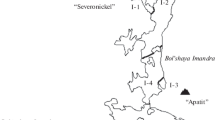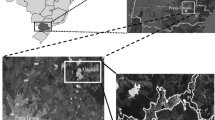Abstract
Conceptions of the influence of geochemical factors on the penetrating ability and bioaccumulation of elements in fish are systematized. Two mechanisms have been proposed to explain the element detoxication in fish: (1) binding of metals by low-molecular sulfur-bearing proteins (metallothionein) with subsequent withdrawal and (2) sequestering in specific granules. It was shown that the low-mineralized and acidified waters provide higher penetrating ability and more intense accumulation of most metals. Most of the elements are better-able to penetrate in fish as ions, however, the large concentrations of Hg are accumulated in form of methylmercury. Original data on the contents and distribution of the majority of toxic elements (Hg, Cd, and Pb) are reported for fish from the Kola North basins. It was justified that the polymetallic contamination of waters causes a decrease of essential elements in the functionally important organs owing to the pathological disturbances. Technogenic-hydrogeochemical anomalies were distinguished in the Kola region (copper-nickel, strontium, and acidified hydrochemical provinces) on the basis of the element abundance in fish and the development of endemic pathophysiological disturbances. The elevated contents of some elements, including toxic metals, in fish in the Volga Basin are used to distinguish the hydrogeochemical provinces in the Lower Volga (Sr-Cd-Al-Cr-Ni), Middle Volga (Hg-Zn), and Upper Volga (Mn-Pb) regions.
Similar content being viewed by others
References
M. M. Brzoska and J. Moniuszko-Jakoniuk, “Interaction between cadmium and zinc in the organism,” Food Chem. Toxicol. 39, 967–980 (2001).
P. G. C. Campbell, “Interactions between trace metals and aquatic organisms: a critique of the free-ion activity model,” in Metal Speciation and Bioavailability in Aquatic Systems, Ed. by A. Tessier and D.R. Turner (Chichester, Wiley, 1995), pp. 45–102.
P. J. Campbell and P. M. Stokes, “Acidification and toxicity of metals to aquatic biota,” Fish. Aquat. Sci. 42(12), 2034–2049 (1985).
C. Conto Cinier, M. Petit-Ramel, R. Faure, and D. Garin, “Cadmium bioaccumulation in ñarp (Cyprino carpio) tissues during long-term exposure: analysis by inductively coupled plasma-mass spectrometry,” Ecotoxicol. Environ. Safety 38, 137–143 (1997).
S. G. George, and P. E. Olsson, “Metallothionein as indicator of trace metal pollution,” in Biomonitoring of Coastal Waters and Estuaries, Ed. by K.J.M. Kramer (CRC Press, Boca Raton, 1994), pp. 151–178.
M. Gochfeld, “Case of mercury exposure, bioavailability and absorption,” Ecotoxicol. Environ. Safety 56, 174–179 (2003).
T. A. Haines, V. T. Komov, V. E. Matey, and C. H. Jagoe, “Perch mercury content is related to acidity and color of 26 Russian lakes,” Water, Air, Soil Pollut. 85, 823–828 (1995).
A. G. Heath, Water Pollution and Fish Physiology (Lewis Publishers, Baton Rouge, 2002).
P. V. Hodson, “The effect of metabolism on uptake, disposition and toxicity in fish,” Aquat. Toxicol. 11, 3–18 (1988).
L. Hollis, J. C. McGeer, D. G. McDonald, and C. M. Wood, “Protective effects of calcium against chronic waterborne cadmium exposure to juvenile rainbow trout,” Environ. Toxicol. Chem. 19, 2725–2734 (2000).
V. T. Komov, I. K. Stepanova, and I. K. Gremyachikh, “Mercury content in muscles of fishes from northwest Russia basins: reasons for intense accumulation and assessment of negative effect on the human health state,” in Actual Problems of Water Toxicology (Inst. Biol. Vnutr. Vod, Borok, 2004), pp. 99–123.
V. V. Kovalsky, Geochemical Ecology (Nauka, Moscow, 1974) [in Russian].
G. F. Landeghem, M. E. Broe, and P. C. D’Haese, “Al and Si: their speciation, distribution, and toxicity,” Clin. Biochem. 31(5), 385–397 (1998).
A. R. Linde, S. Sanchez-Galan, P. Valles-Mota, and E. Garcia-Vasquez, “Metallothionein as bioindicator of freshwater metal pollution: European Eel and Brown Trout,” Ecotoxicol. Environ. Safety 49, 60–63 (2001).
D. G. McDonald and C. M. Wood “Metal bioavailability and mechanism of toxicity,” in Proceeding 14 annual SETAC-meeting (Houston, 2001), pp. 23–27.
J. C. McGeer, C. Szebedinszky, D. G. McDonald, and C. M. Wood, “The role of dissolved organic carbon in moderating the bioavailability and toxicity of Cu to rainbow trout during chronic waterborne exposure,” Comp. Biochem. Physiol. Part C. 133, 147–160 (2002).
T. I. Moiseenko and L. P. Kudryavtseva, “Ecotoxicological assessment of anthropogenic hydrogeochemical anomalies: an example being the Kola mining and metallurgical complex,” Geochem. Int. 37(10), 1000–1017.
T. I. Moiseenko, and L. P. Kudryavtseva, “Trace Metals accumulation and fish pathologies in areas affected by mining and metallurgical enterprises,” Environ. Pollut. 114(2), 285–297 (2002).
T. I. Moiseenko, N. A. Gashkina, Yu. L. Sharova, and L. P. Kudryavtseva, “Ecotoxicological assessment of water quality and ecosystem health: a case study of the Volga river,” Ecotoxicol. Environ. Safety 71, 837–870 (2008).
T. I. Moiseenko, L. P. Kudryavtseva, and N. A. Gashkina, Trace Elements in Terrestrial Surface Waters: Technophilic Properties, Bioaccumulation, and Ecotoxicology (Nauka, Moscow, 2006) [in Russian].
T. I. Moiseenko, L. P. Kudryavtseva, and N. A. Gashkina, “Assessment of the geochemical background and anthropogenic load by bioaccumulation of microelements in fish,” Water Resour. 32(6), 640–652 (2005).
J. Moore and S. Ramamurthy, Heavy Metals in Natural Waters (Springer, New York, 1984).
W. O. Nelson and P. G. C. Campbell, “The effects of acidification on the geochemistry of Al, Cd, Pb and Hg in freshwater environments: a literature review,” Environ. Pollut. 71, 91–130 (1991).
M. C. Newman and Ch. H. Jagoe, Ecotoxicology: a Hierarchical Treatment (Lewis, New York, 1996).
P. O. Olsson, M. Zafarullah, L. Gedamu, R. Foster, and T. Hamor, “Developmental regulation of metallothionein mRNA, zinc and copper levels in rainbow trout (Salmo gairdneri),” Europ. J. Biochem. 193, 229–235 (1990).
C. S. Perez-Coll, J. Herkovitz, O. Fridman, P. Daniel, and J. L. D’Eramo, “Metallothioneins and cadmium uptake by the liver in Bufo Arenarum,” Environ. Pollut. 97, 311–315 (1997).
D. J. H. Phillips and P. S. Rainbow, “Strategies of trace metal sequestration in aquatic organisms,” Mar. Environ. Res. 49, 83–93 (1989).
A. B. S. Poleo, K. Ostbye, S. A. Oxnevad, R. A. Andersen, E. Heibo, and L. A. Vollestad, “Toxicity of acid aluminium-rich water to seven freshwater fish species: a comparative laboratory study,” Aquatic Toxicol. 21, 435–447 (1997).
W. L. Reichert, D. A. Federighi, and D. C. Malins, “Uptake and metabolism of lead and cadmium in coho salmon (Oncorhynchus kisutch),” Comp. Biochem. Physiol. 63C, 221–229 (1979).
I. V. Rodushkin, T. I. Moiseenko, and L. P. Kudravtseva, “Aluminium in the surface waters of the Kola Peninsula, Russia,” Sci. Total Environ. 163, 55–59 (1995).
G. Roesijadi, “Metallothionein in metal regulation and toxicity in aquatic animals,” Aquat. Toxicol. 22, 84–114 (1991).
B. O. Rosseland, and Ì. Staurnes, “Physiological mechanisms for toxic effects and resistance to acidic water: an ecophysiological and ecotoxicological approach,” in Acidification of Freshwater Ecosystem: Implications for the Future, Ed. by C.E.W. Steinberg and R.F. Wright (Wiley, Chichester, 1994), pp. 227–246.
K. Simkiss, Ecotoxicant at the Cell-Membrane Barrier Ecotoxicology: a Hierarchical Treatment, Ed. by M.C. Newman and Ch.H. Jagoe (Lewis, New York, 1996), pp. 59–84.
K. A. Sloman, G. R. Scott, and D. Zhongyu, “Cadmium affects the social behavior rainbow trout, Onconrhynchus mykiss,” Aquat. Toxicol. 65, 171–185 (2003).
D. J. Spry and J. G. Wiener, “Metal bioavailability and toxicity to fish in low-alkalinity lakes: a critical review,” Environ. Pollut. 71, 243–304 (1991).
C. J. Watras, R. C. Back, S. Halvorsen, R. J. M. Hudson, K. A. Morrison, and S. P. Wente, Bioaccumulation of mercury in pelagic freshwater food webs, Sci. Total Environ. 219, 208 (1998)
C. M. Wood, “Toxic responses of the gill,” in Target Organ Toxicity in Marine and Freshwater Teleosts, Ed. by D. Schlenk and W.H. Benson (Taylor and Francis, London, 2001), pp. 1–89.
D. A. Wright, “Trace metal and major ion interactions in aquatic animals,” Mar. Pollut. Bull. 31, 8–18 (1995).
Author information
Authors and Affiliations
Corresponding author
Additional information
Original Russian Text © T.I. Moiseenko, 2015, published in Geokhimiya, 2015, No. 3, pp. 222–233.
Rights and permissions
About this article
Cite this article
Moiseenko, T.I. Impact of geochemical factors of aquatic environment on the metal bioaccumulation in fish. Geochem. Int. 53, 213–223 (2015). https://doi.org/10.1134/S001670291503009X
Received:
Accepted:
Published:
Issue Date:
DOI: https://doi.org/10.1134/S001670291503009X




